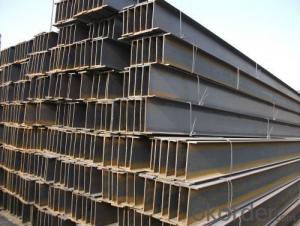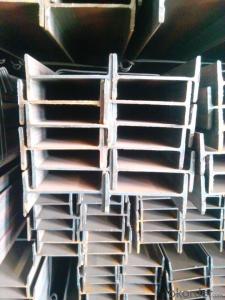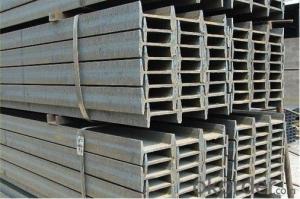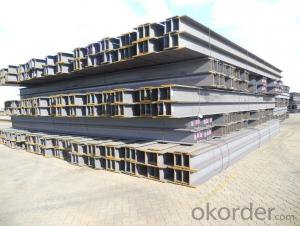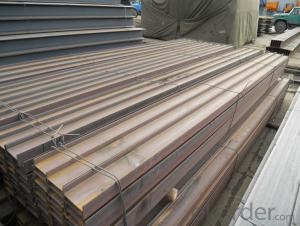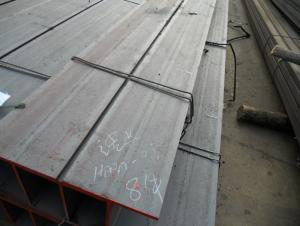H-Type Steel or H Beam Steel Section High Quality
- Loading Port:
- China main port
- Payment Terms:
- TT OR LC
- Min Order Qty:
- 50 m.t.
- Supply Capability:
- 10000 m.t./month
OKorder Service Pledge
OKorder Financial Service
You Might Also Like
Item specifice
H-Type Steel or H Beam Steel Section Made in China
Product Description:
OKorder is offering H-Type Steel or H Beam Steel Section Made in China at great prices with worldwide shipping. Our supplier is a world-class manufacturer of steel, with our products utilized the world over. OKorder annually supplies products to European, North American and Asian markets. We provide quotations within 24 hours of receiving an inquiry and guarantee competitive prices.
Product Applications:
H-Type Steel or H Beam Steel Section Made in China are ideal for structural applications and are widely used in the construction of buildings and bridges, and the manufacturing, petrochemical, and transportation industries.
H beam is widely used in various building structure and engineering structure:
a).used for the plant, high-rise building construction
b).used for the bridge, shipment building
c).used for lifting and transportation machinery, equipment manufacturing base building
d).used for the support, foundation pile manufacturing
Main Product Features:
· Premium quality
· Prompt delivery & seaworthy packing (30 days after receiving deposit)
· Corrosion resistance
· Can be recycled and reused
· Mill test certification
· Professional Service
· Competitive pricing
Product Specifications:
1. Standard: JIS G3192 OR GB/T11263-2005
2. Grade: Q235/SS400/S235JR
3. Length: 6m-12m
4. Packing:standard export packagin
| STANDARD: JIS G3192 OR GB/T11263-2005 | |||
| H beam Section sizenma(mm) | Weight (kg/m) | ||
| Height×Breadth | Web thichness | Flange thichness | |
| 100×100 | 6 | 8 | 16.9 |
| 125×125 | 6.5 | 9 | 23.6 |
| 150×150 | 7 | 10 | 31.1 |
| 175×175 | 7.5 | 11 | 40.4 |
| 200×200 | 8 | 12 | 49.9 |
| 250×250 | 9 | 14 | 71.8 |
| 300×300 | 10 | 15 | 93.0 |
| 300×300 | 15 | 15 | 105.0 |
| 350×350 | 12 | 19 | 134.9 |
| 400×400 | 13 | 21 | 171.7 |
| 148×100 | 6 | 9 | 20.7 |
| 194×150 | 6 | 9 | 29.9 |
| 244×175 | 7 | 11 | 43.6 |
| 294×200 | 8 | 12 | 55.8 |
| 340×250 | 9 | 14 | 78.1 |
| 390×300 | 10 | 16 | 104.6 |
| 440×300 | 11 | 18 | 120.8 |
| 482×300 | 11 | 15 | 110.8 |
| 488×300 | 11 | 18 | 124.9 |
| 582×300 | 12 | 17 | 132.8 |
| 588×300 | 12 | 20 | 147.0 |
| 100×50 | 5 | 7 | 9.3 |
| 125×60 | 6 | 8 | 13.1 |
| 150×75 | 5 | 7 | 14.0 |
| 175×90 | 5 | 8 | 18.0 |
| 198×99 | 4.5 | 7 | 17.8 |
| 200×100 | 5.5 | 8 | 20.9 |
| 248×124 | 5 | 8 | 25.1 |
| 250×125 | 6 | 9 | 29.0 |
| 298×149 | 5.5 | 8 | 32.0 |
| 300×150 | 6.5 | 9 | 36.7 |
| 346×174 | 6 | 9 | 41.2 |
| 350×175 | 7 | 11 | 49.4 |
| 396×199 | 7 | 11 | 56.1 |
| 400×200 | 8 | 13 | 65.4 |
| 446×199 | 8 | 12 | 65.1 |
| 450×200 | 9 | 14 | 74.9 |
| 496×199 | 9 | 14 | 77.9 |
| 500×200 | 10 | 16 | 88.1 |
| 596×199 | 10 | 15 | 92.4 |
| 600×200 | 11 | 17 | 103.4 |
| 700×300 | 13 | 24 | 181.8 |
| 800×300 | 14 | 26 | 206.8 |
| 900×300 | 16 | 28 | 240.1 |

- Q:What are the installation requirements for steel H-beams?
- The installation requirements for steel H-beams typically include ensuring proper alignment, adequate support, and secure connections. It is important to follow manufacturer guidelines and local building codes to determine the appropriate size, spacing, and attachment methods for H-beam installation. Additionally, professional expertise and specialized equipment may be necessary for lifting and positioning the beams accurately.
- Q:What are the maintenance requirements for steel H-beams?
- The maintenance requirements for steel H-beams mainly involve regular inspections, cleaning, and protection against corrosion. To ensure the structural integrity of steel H-beams, it is important to conduct regular inspections. This can involve visually inspecting the beams for any signs of damage, such as cracks, rust, or structural deformities. If any issues are identified, they should be addressed promptly to prevent further deterioration. Cleaning the steel H-beams is also crucial to maintain their performance. The beams can accumulate dirt, dust, and other contaminants over time, which can potentially impact their structural integrity. Cleaning can be done using appropriate methods, such as pressure washing or using non-abrasive cleaning agents. It is important to avoid using abrasive materials or cleaning agents that can cause damage to the steel surface. Another critical aspect of maintenance is protecting the steel H-beams against corrosion. Steel is prone to rust and corrosion when exposed to moisture and certain environmental conditions. To prevent corrosion, it is advisable to apply protective coatings, such as paint or galvanization, to the steel beams. These coatings act as a barrier, preventing moisture and other corrosive elements from reaching the steel surface. Furthermore, if the steel H-beams are installed in environments with high humidity, corrosive chemicals, or extreme temperatures, additional measures may be necessary. This could include periodic reapplication of protective coatings or implementing measures to control environmental conditions, such as humidity control or temperature regulation. Overall, regular inspections, cleaning, and corrosion protection are essential maintenance requirements for steel H-beams to ensure their long-term durability and structural performance. Following these maintenance practices will help extend the lifespan of the beams and prevent any potential safety risks.
- Q:How do you calculate the torsional constant for steel H-beams?
- The torsional constant for steel H-beams can be calculated using the formula C = (2Sb^3)/(3Gt), where C is the torsional constant, S is the section modulus of the beam, b is the flange width, G is the shear modulus of elasticity for the steel, and t is the thickness of the flange.
- Q:Can steel H-beams be used in sports arena structures?
- Indeed, sports arena structures can make use of steel H-beams. These beams are frequently utilized in construction because of their impressive strength-to-weight ratio, which renders them suitable for bearing heavy loads. Given that sports arenas necessitate robust structural elements to uphold the weight of the roof, seating, and other equipment, H-beams prove to be indispensable in providing the requisite strength and stability to endure the forces exerted on the structure during events. Moreover, the fabrication and assembly of steel H-beams are easily accomplished, enabling the efficient construction of sports arena structures. Their versatility further allows architects and engineers to conceive original and inventive arena layouts that accommodate various seating arrangements and architectural features. Furthermore, steel H-beams possess durability and resistance to environmental factors like corrosion, making them an ideal choice for constructing long-lasting sports arena structures. The material's low maintenance requirements further contribute to its popularity in construction projects. All in all, steel H-beams represent a dependable and widely employed option for sports arena structures, delivering the essential strength, versatility, and durability required for such large-scale endeavors.
- Q:What are the acoustic properties of steel H-beams?
- Steel H-beams, also referred to as I-beams, possess a variety of unique acoustic qualities due to their composition and form. To begin with, steel is an exceedingly dense and inflexible substance, which contributes to its exceptional sound transmission capabilities. H-beams constructed from steel can effectively transfer sound energy, enabling them to efficiently conduct sound waves. This particular attribute renders steel H-beams a prime selection in construction scenarios where soundproofing or acoustic isolation is desired. Furthermore, the shape of H-beams plays a significant role in their acoustic characteristics. The design of H-beams in the shape of the letter "I" aids in the even distribution of sound waves across the cross-sectional area, thereby minimizing energy concentration at specific points. This dispersion of sound energy can prevent the occurrence of resonances or standing waves, which may result in undesirable vibrations and noise. Additionally, steel H-beams possess a high natural frequency, which pertains to the rate at which an object naturally vibrates. The elevated natural frequency of steel H-beams aids in the attenuation of low-frequency sounds. Low-frequency noise, such as that produced by heavy machinery or traffic rumble, is effectively absorbed and dampened by the steel H-beams, resulting in a quieter environment. Lastly, steel H-beams exhibit commendable structural stability and are capable of effectively resisting vibrations caused by external forces or impacts. This stability diminishes the likelihood of sound distortion or reverberation within the beam itself, guaranteeing that sound waves pass through without notable alterations. In conclusion, the acoustic properties of steel H-beams are characterized by their efficient sound transmission, dispersion of sound energy, attenuation of low-frequency noise, and structural stability. These qualities render steel H-beams an appealing option for applications that necessitate effective soundproofing, acoustic isolation, and vibration resistance.
- Q:Can steel H-beams be used for long-span structures?
- Long-span structures can indeed utilize steel H-beams. These beams are widely employed in construction owing to their exceptional strength-to-weight ratio and versatility. They possess the capability to span considerable distances without necessitating supplementary support columns or beams. The H-shaped design ensures structural stability and even distribution of the load, rendering them suitable for long-span structures such as bridges, high-rise buildings, and industrial facilities. Moreover, steel H-beams can be easily fabricated and interconnected, facilitating efficient construction and customization to meet specific design requirements. Overall, steel H-beams are a highly favored option for long-span structures due to their robustness, endurance, and cost-effectiveness.
- Q:Can steel H-beams be used in the construction of shopping malls?
- Yes, steel H-beams can be used in the construction of shopping malls. Steel H-beams are commonly used in the construction industry due to their strength and durability. They provide structural support and are often used in the construction of large buildings, including shopping malls. Steel H-beams can withstand heavy loads and provide stability, making them an ideal choice for constructing the framework of shopping malls. Additionally, steel is a sustainable and cost-effective material, making it a popular choice in commercial construction projects.
- Q:Can steel H-beams be used in swimming pool structures?
- Yes, steel H-beams can be used in swimming pool structures. They are commonly used as structural support elements due to their high strength and durability. Additionally, steel H-beams can withstand the corrosive environment of a swimming pool, making them a suitable choice for such structures.
- Q:What are the different span lengths achievable with steel H-beams?
- The span lengths achievable with steel H-beams can vary depending on several factors such as the size and weight of the beam, the load it needs to support, and the specific design requirements of the project. However, generally speaking, steel H-beams can achieve span lengths ranging from a few feet to several hundred feet. For smaller residential or commercial projects, H-beams with span lengths of 10 to 20 feet are commonly used. These beams can adequately support typical loads such as floor joists, roof trusses, or small bridges. For larger industrial or infrastructure projects, steel H-beams with much longer span lengths are utilized. In these cases, the beams can be designed to span over 100 feet or even several hundred feet. This allows for the construction of large-scale structures like warehouses, factories, bridges, or high-rise buildings. It's important to note that achieving longer span lengths with steel H-beams might require additional structural supports, such as columns or piers, to ensure the beam's stability and load-bearing capacity. Additionally, professional structural engineers and architects should be involved in the design process to ensure that the chosen beam size and span length are appropriate for the specific project requirements and safety standards.
- Q:Are Steel H-Beams resistant to mold or mildew?
- Yes, steel H-beams are resistant to mold or mildew growth due to their non-porous and non-organic nature.
1. Manufacturer Overview |
|
|---|---|
| Location | |
| Year Established | |
| Annual Output Value | |
| Main Markets | |
| Company Certifications | |
2. Manufacturer Certificates |
|
|---|---|
| a) Certification Name | |
| Range | |
| Reference | |
| Validity Period | |
3. Manufacturer Capability |
|
|---|---|
| a)Trade Capacity | |
| Nearest Port | |
| Export Percentage | |
| No.of Employees in Trade Department | |
| Language Spoken: | |
| b)Factory Information | |
| Factory Size: | |
| No. of Production Lines | |
| Contract Manufacturing | |
| Product Price Range | |
Send your message to us
H-Type Steel or H Beam Steel Section High Quality
- Loading Port:
- China main port
- Payment Terms:
- TT OR LC
- Min Order Qty:
- 50 m.t.
- Supply Capability:
- 10000 m.t./month
OKorder Service Pledge
OKorder Financial Service
Similar products
New products
Hot products
Hot Searches
Related keywords
